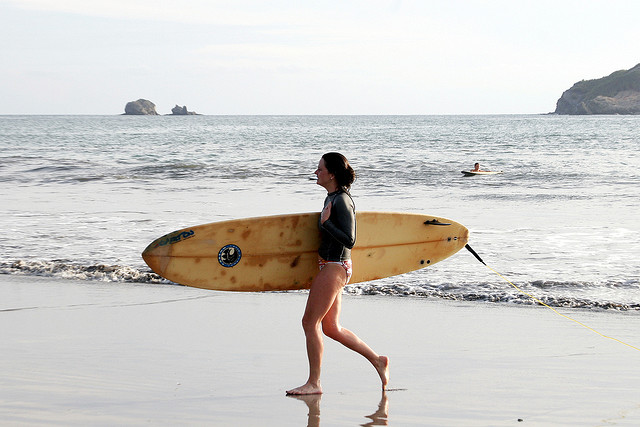A brief encounter with two pro surfers at the Dollar Rental Car agency in San José’s international airport colored my first impression of Costa Rica’s southern Nicoya Peninsula. I was standing in line with a visiting friend when a pair of blonde males emerged from behind multiple surfboards and a heap of brand new Quicksilver luggage. We signed the requisite paperwork and looked for our cars. Eclipsing our tiny Suzuki was a massive pearl-white 4-wheel drive SUV. Curious if size mattered on their journey, we learned that roads on the Nicoya Peninsula could be as challenging as the surf. “That’s not a place for sunbathers and body boarders,” I thought. During a recent visit, I realized that I couldn’t have been more wrong.
A long stretch of sand lines Costa Rica’s southern Nicoya Peninsula. The coastline’s pristine beaches start at Montezuma and wind around to the world-class surfing destinations of Malpaís, Playa Carmen and Playa Santa Teresa. Most of the shoreline is rocky and reserved for the pros; however, a sandy-bottomed slice of Pacific along Playa Santa Teresa invites beginning surfers. What’s more, sunbathers can indulge in plenty natural shade beneath the towering almond trees that hug the sand.
The best part is that great waves are abundant. Travelers used to surfing crowded spots such as Santa Barbara, California’s, Rincon beach, feel like kids in a candy store. And first-timers have the space they need to get up and fall down and get up and fall down. “The locals are all pura vida,” said one California body boarder when describing the local vibe (“Pura vida” is a Costa Rican expression used to express “the good life.”). With so many waves to go around, there is little incentive to do anything else but share in the pura vida.
The invitation to share the surf extends to both pros and beginners. In fact, many of the local experts teach surfing. The hardest part is choosing a class to meet your needs. Surf shops offer classes as do many private tutors throughout the area. A quick walk along the narrow dirt road connecting the beaches reveals numerous signs advertising surf lessons, and friends-of-friends working in hotels will also have suggestions. At just about any given moment, there are tourists braving a beginning surf lesson. To really do your homework, it is best to find out what each person has liked and disliked so far about their experience.
Safety should be a priority when choosing a surf academy. Learning about potential hazards before paddling out is vital. Except for a section of Playa Santa Teresa, most of the coast is rocky. Beginning surf lessons are also taught at Playa Carmen, where the waves often roll gently to shore. The biggest concern at Playa Carmen, according to many local surf instructors, is that rocks dot the area. This is why most instructors prefer to take students to Santa Teresa beach.
Selecting an instructor adept at communicating safety concerns is also important. In addition to learning how to stand up on a board, you also need to learn how to fall. Most students are provided standard fiberglass surf boards; however, if you are an absolute beginner, it may be best to choose a school that has access to soft-top boards.
Outside of an adventurous spirit, there is little else surf enthusiasts need to pack. Surf boards and body boards are available for rent, and the water is warm enough to forgo a wetsuit year round. Most surfers just wear a swimsuit and a rash guard. Those eager to spend several hours a day riding the waves bring a hat with a chin strap.
Costa Rica’s southern Nicoya Peninsula is unique in the way it challenges pro surfers and welcomes beginners. Still, there is one major challenge all visitors have to face—getting there. While it is easy to jump on a quick flight to Tambor, the roughest part of the journey remains. In the end, size does matter. Weather conditions often prohibit vehicles that are not 4-wheel-drive equipped past the town of Cóbano. Travelers arriving by public bus often have to get off in Cóbano and take a 4-wheel drive taxi to Malpaís, Playa Carmen and Playa Santa Teresa, located 10 kilometers down the road. (Montezuma is just four kilometers from Cóbano on a different road.).
As is the case with many remote beach locations around the world, the road helps the community retain what one French-Canadian I met described as a “savage” feel for its lush surroundings. (Note: Santa Teresa is not without a luxury element in terms of both food and accommodation. After all, it has attracted some of Hollywood’s moneyed elite.) Regardless, whether you are a pro surfer on a budget looking for that perfect wave or a beginner with deep pockets on a surfin’ safari, could there possibly be a better setting to stage your adventure than a “savage” stretch of beach reached by way of a rough dirt road?
Photos by: flip.and.serena, mikebaird

